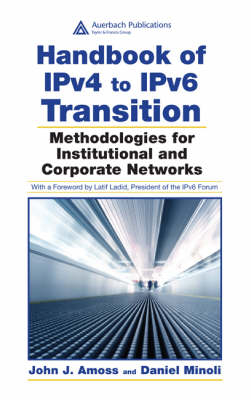
Handbook of IPv4 to IPv6 Transition
Methodologies for Institutional and Corporate Networks
Seiten
2007
Auerbach (Verlag)
978-0-8493-8516-2 (ISBN)
Auerbach (Verlag)
978-0-8493-8516-2 (ISBN)
Addresses the migration and macro-level scalability requirements to support DoD/DIS/GAO drive for an IPv6-based US Government migration by 2007. This work discusses capabilities, network constructs, AutoConfiguration techniques, the suite of IPv6, and related protocols. It also examines Enterprise/Institutional network migration scenarios.
The implementation of IPv6 is essential to the continued growth of the Internet and the development of new applications. The Handbook of IPv4 to IPv6 Transition Methodologies provides a wealth of best practices and procedures that will help corporations plan and implement a smooth transition to IPv6.
A blueprint for successful transition, the Handbook of IPv4 to IPv6 Transition—
Provides a tutorial of IPv6 addressing capabilities
Looks at IPv6 network constructs, specifically key routing processes
Examines IPv6 autoconfiguration techniques and the suite of IPv6-related protocols
Discusses all the major IPv6 enterprise/institutional network migration mechanisms as well as coexistence issues
Identifies the various elements in the network and what migration role they will need to play in order to support the transition
Surveys the application and security aspects of the IPv6 transition
Offers the first reference in many years to address the migration and macro-level scalability requirements to support the DoD/DISA/GAO drive for an IPv6-based U.S. Government
The implementation of IPv6 is essential to the continued growth of the Internet and the development of new applications. The Handbook of IPv4 to IPv6 Transition Methodologies provides a wealth of best practices and procedures that will help corporations plan and implement a smooth transition to IPv6.
A blueprint for successful transition, the Handbook of IPv4 to IPv6 Transition—
Provides a tutorial of IPv6 addressing capabilities
Looks at IPv6 network constructs, specifically key routing processes
Examines IPv6 autoconfiguration techniques and the suite of IPv6-related protocols
Discusses all the major IPv6 enterprise/institutional network migration mechanisms as well as coexistence issues
Identifies the various elements in the network and what migration role they will need to play in order to support the transition
Surveys the application and security aspects of the IPv6 transition
Offers the first reference in many years to address the migration and macro-level scalability requirements to support the DoD/DISA/GAO drive for an IPv6-based U.S. Government
Amoss, John J.; Minoli, Daniel
Introduction and Overview. IPv6 Addressing. IPv6 Network Constructs. IPv6 AutoConfiguration Techniques. IPv6 and Related Protocols. Transition Approaches and Mechanisms. IPv6 Network Software and Hardware. Implementing IPv6 Transition Strategies. IPv6 Applications. Security in IPv6 Networks. Appendices.
| Erscheint lt. Verlag | 24.12.2007 |
|---|---|
| Verlagsort | London |
| Sprache | englisch |
| Maße | 156 x 234 mm |
| Gewicht | 620 g |
| Themenwelt | Informatik ► Netzwerke ► TCP / IP und IPv6 |
| Mathematik / Informatik ► Informatik ► Theorie / Studium | |
| Technik ► Elektrotechnik / Energietechnik | |
| Technik ► Umwelttechnik / Biotechnologie | |
| ISBN-10 | 0-8493-8516-4 / 0849385164 |
| ISBN-13 | 978-0-8493-8516-2 / 9780849385162 |
| Zustand | Neuware |
| Haben Sie eine Frage zum Produkt? |
Mehr entdecken
aus dem Bereich
aus dem Bereich
Protokolle, Routing, Dienste, Sicherheit
Buch | Softcover (2023)
dpunkt (Verlag)
CHF 55,85
The Implementation
Buch | Softcover (2018)
Addison Wesley (Verlag)
CHF 109,20


